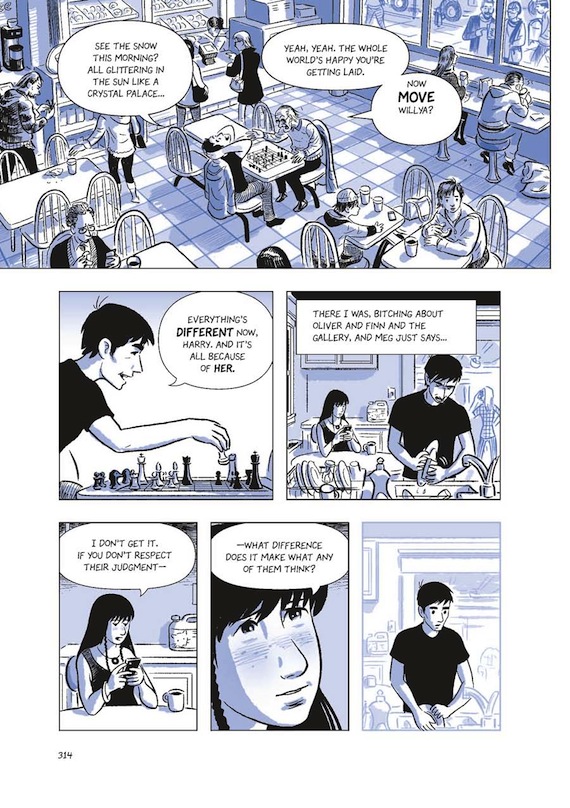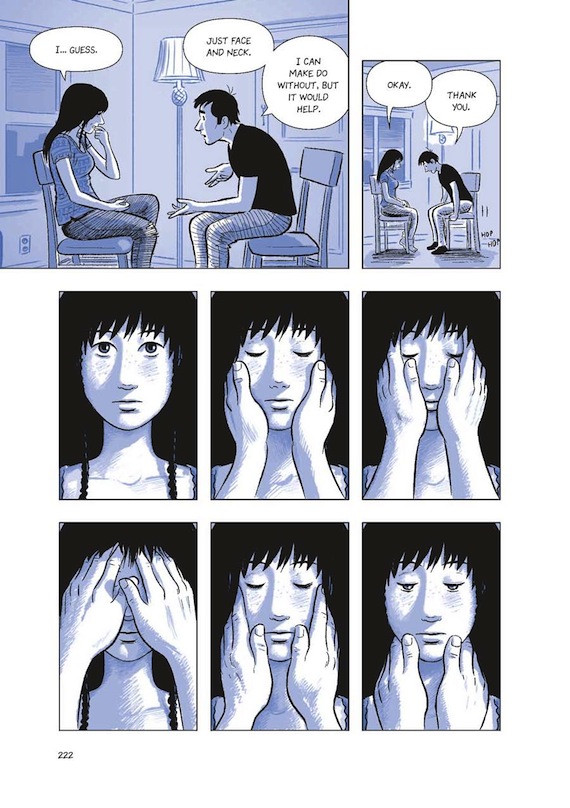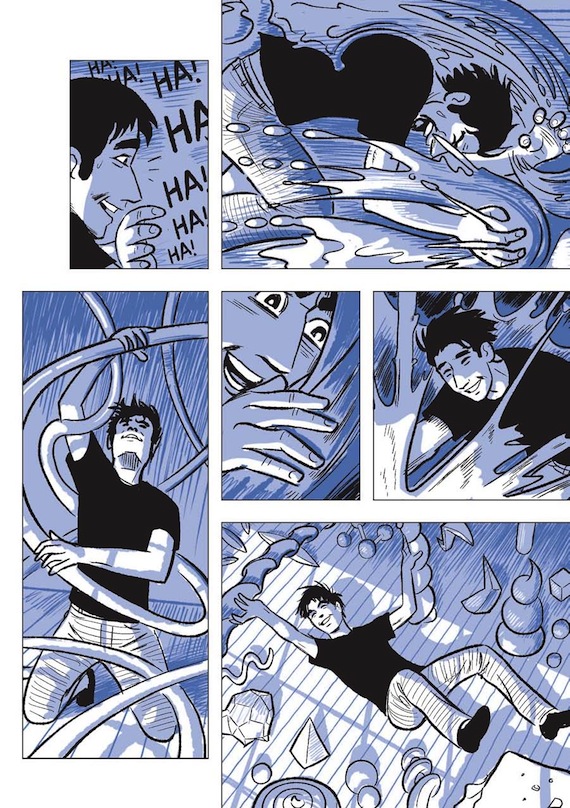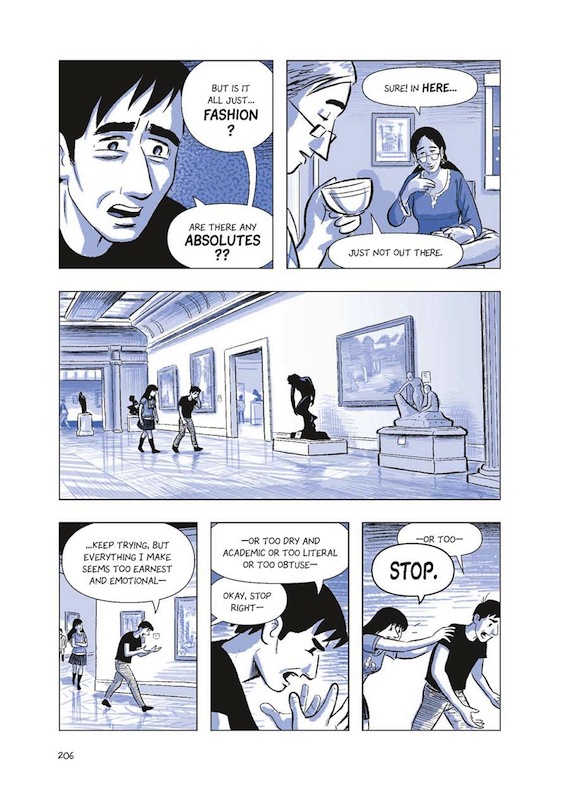The comics theorist Scott McCloud has a status no one in the comics community should have. At the MLA Conference in Vancouver last January, I attended a comics studies panel at which the respondent chastised academics who cite McCloud and only McCloud, ignoring the 22 years of scholarship that followed the publication of his book Understanding Comics. McCloud compares himself to Sigmund Freud. He may be wrong about everything, he says, but he was the first in his field — or almost the first — and everyone still has to grapple with his ideas.


 Whatever his status, McCloud is really a professional amateur, a journeyman who’s spent most of his career pursuing a series of intriguing small projects. In the late ’80s and early ’90s, he wrote and drew Zot!, an independent black-and-white superhero series. He maintains a website, where, pivoting off of ideas from his 2000 book Reinventing Comics, he develops “inventions” that rethink the comics form for the digital age. In 2006, he wrote the instructional book Making Comics. Last month, First Second published his first graphic novel, The Sculptor, which one approaches with the curiosity one once approached the first novels of Lionel Trilling or James Wood. It is the ambitious first attempt by an important critic to write and draw if not the Great American Graphic Novel, then at least a good American graphic novel.
Whatever his status, McCloud is really a professional amateur, a journeyman who’s spent most of his career pursuing a series of intriguing small projects. In the late ’80s and early ’90s, he wrote and drew Zot!, an independent black-and-white superhero series. He maintains a website, where, pivoting off of ideas from his 2000 book Reinventing Comics, he develops “inventions” that rethink the comics form for the digital age. In 2006, he wrote the instructional book Making Comics. Last month, First Second published his first graphic novel, The Sculptor, which one approaches with the curiosity one once approached the first novels of Lionel Trilling or James Wood. It is the ambitious first attempt by an important critic to write and draw if not the Great American Graphic Novel, then at least a good American graphic novel.
 The Sculptor tells the story of a 26-year-old man trying to make it as an artist in New York. He strikes a Faustian bargain with Death that allows him to sculpt any matter his hands touch into the visions he carries in his mind’s eye. In return, he will die in 200 days. He has no immediate family left, and only a few friends he will be leaving behind. After agreeing to the deal, he falls in love with a woman.
The Sculptor tells the story of a 26-year-old man trying to make it as an artist in New York. He strikes a Faustian bargain with Death that allows him to sculpt any matter his hands touch into the visions he carries in his mind’s eye. In return, he will die in 200 days. He has no immediate family left, and only a few friends he will be leaving behind. After agreeing to the deal, he falls in love with a woman.
I talked to McCloud in Seattle on February 12. We met at a café in the U-District a couple hours before his appearance at the University Bookstore. The following is a pared-down transcript of a one-hour conversation.
The Millions: After reading the [Understanding Comics] trilogy and looking at all the experiments you’ve been doing online, it surprised me to discover that The Sculptor is, formally-speaking, a very conservative book.
Scott McCloud: I agree. I’d describe it the same way.
 TM: You’re not playing any tricks. There’s no Chris Ware Building Stories attempt along the lines of “let’s see all the games I can play with this idea called the book.” These are the tried-and-true techniques of graphic-novel storytelling. Why was it so conservative?
TM: You’re not playing any tricks. There’s no Chris Ware Building Stories attempt along the lines of “let’s see all the games I can play with this idea called the book.” These are the tried-and-true techniques of graphic-novel storytelling. Why was it so conservative?
SM: Well after trying to make visible all of these various techniques, I wanted, as much as possible, to bury them, to conceal them. I am something of a formalist and one of the formalist tricks that we like to check off as we’re going down the list of things we can do is to impersonate our opposite number. To become a more intuitive pure storyteller and not necessarily call attention to formal artifacts that previously we were hoping to call attention to.
At the same time, I don’t think it was necessarily backwards looking. I was trying to move towards a sort of comic that I wasn’t seeing being done. I would say that in the past decades, there weren’t that many comics like this one, in terms of the way it incorporates reader participation, [which is] something I see in manga but rarely see in American comics. The use of lettering and coloring choices [are] geared towards mapping out the intention and consciousness of the protagonist. I haven’t seen that done much, but I was employing [these concepts] all in the interest of the story. So they lurked quietly in the background and they helped buttress the story.

TM: The question of reader participation is a tricky one. I can read a prose novel and forget that I’m reading words on a page, but it’s impossible for me to read a comic and remain unaware of the fact that I’m reading a comic. That awareness leads to reader participation.
SM: I agree with you to an extent about there being a fundamental reader participation component to comics and that achieving that transparency in comics is a lot harder than it is in novels. But I don’t think it’s impossible. And I think younger readers achieve it much more often than we do as adults. And I wanted to see if I could get that across. It wasn’t easy, but I think I achieved it and I am getting a lot of feedback from people who do have that sensation of being lost, and getting caught up in the story and just seeing the characters as human beings.
In comics, if you open with a street scene, people are going to see drawings of a street scene. And every time they move from one artist to the next those drawings are going to be different. And each change of style just becomes a reiteration of the fact that those are just lines on paper. And I don’t think that’s the case with film and I don’t think that’s the case with prose because…they both relate a world in a relatively seamless way. In the one case [it’s] from the verisimilitude that comes from straight photography. In the other case, [it’s] with the verisimilitude that comes from the consistent texture of our imagination.
Comics puts up a lot of barriers. I think one way to get around those barriers is consistency of approach and length. This is a very long book, so people have time to adjust to my style. It’s not just a little 22-page packet. [Hopefully in my case], by paying close attention to the rhythms of real people in conversation and things like facial expressions and body language, [I] managed to bring a little life into the characters so they pop from the page more than in things I’ve done in the past.

TM: Your characters are good-looking. This isn’t Daniel Clowes.
SM: No, they come from a more attractive, heroic tradition, partially because I don’t have the skill to pull off something less generic.
TM: Are there any other reasons for that?
SM: I’m drawn as a viewer to that, and as a romance I think it would have been entirely possible to tell a story like this while creating characters that were physically unappealing, but I’m just not that good. And so this fell into that general familiar realm of a romance in which both characters are on some level attractive. It’s not a barrier I was prepared to cross when I was trying to cross so many others. Certainly, the business of learning to write and of learning to draw was going to keep me busy from beginning to end. Trying to do something more subtle or more unconventional with the character design just wasn’t within my skill set.
TM: Zot!, by your own admission is filled with many mistakes. It’s not slick.
SM: No, not at all. It was my very first book.
TM: You were learning. The movements aren’t right. You don’t always know where your eye is supposed to go based on the composition of the page. I won’t continue on, because that’s just mean. I have to say for myself that part of what drew me to reading comics or what drew me back to comics when I was 19, wasn’t so much about looking for masterpieces. It was about enjoying the mistakes, enjoying comics as a form of handwriting, enjoying the lack of slickness. I often feel that what we call great comics have a problem, because the better and more slick you make them the more you lose something. This medium makes these mistakes look aesthetically pleasurable in a way that they’re not in a prose novel.
SM: I’ve long been aware of that way of looking at comics and sometimes I share that perspective. But then there are other artists who are prominent exceptions to that. It’s not my primary passion to look for that. It’s not what I hope for in comics. It’s something I accept as something that can make comics warmer and more appealing. But it’s not a prerequisite for things I love in comics. And I do enjoy comics that are much more finely tuned.
I think that Jim Woodring, for example, very rarely has a line out of place. His craftsmanship is absolutely impeccable. I don’t wish that his line was more unsteady or that his pen would run out of ink halfway through. I’m glad that those lines are complete because I think it enhances the work. Likewise, I think Chris Ware’s control is one of the elements of his work that I value.

Nevertheless, when I was working on The Sculptor, even though it was done digitally, I went through great pains to make sure that the line that I used was, if anything, somewhat uneven. [I designed] my brushes in photoshop [with] a pretty grotty line. If you look closely you’ll see that it’s very knobby and imprecise. But that’s simply because I thought it gave it a warmth that I liked rather than that clean vector line.
TM: You made a point in Understanding Comics about how time equals space in comics. These full-page panels at the end of The Sculptor are meant to represent the elongation of a moment. [Note: We are not showing you these pages in order to avoid spoilers.] It’s the comics equivalent of slow-motion. As a reader, I feel it’s my responsibility to read these pages very slowly.
SM: Actually, could I just say that as an artist and writer I don’t feel that it’s the reader’s responsibility. It’s the responsibility of me as the storyteller to give the reader cues that would encourage them to quite naturally read at a slower pace.
TM: Yes, but it’s very easy to flip through this and not feel the duration of time.
SM: My hope as a storyteller is that I embedded enough density of detail, enough narrative density that the eye would begin to slow as well. That I put enough speed bumps [in] the growing complexity of those pages, that people would more naturally slow down. I can’t control that, but it’s my intention to give the eye more incentive to move more slowly through those pages, to slow down time. I don’t think the reader has any responsibility at all. The reader, technically, doesn’t have any responsibility to read from left to right. But it’s usually to the mutual benefit of reader and artist to do it that way.
TM: So you don’t believe the reader should be doing work?
SM: No, I just don’t believe in the idea of responsibility. The reader should encounter the work in whatever way the reader thinks is beneficial to themselves. And 99 times out of 100 that means reading the work in the expected way.
TM: How do you handle the differing experiences various readers will have based on the various paces with which they will approach these pages?
SM: Well, there’s an ideal duration and I’m trying to pitch the delivery in such a way that to the best of my abilities most readers will experience it as I intended. I just accept that it’s not mine to control. I can only encourage it.
 TM: In a review I wrote of Best American Comics 2014 [which McCloud guest-edited], I noted that great comics, unlike great fiction, are allowed to be sentimental. I think The Sculptor is a case in point. It is a very sentimental book.
TM: In a review I wrote of Best American Comics 2014 [which McCloud guest-edited], I noted that great comics, unlike great fiction, are allowed to be sentimental. I think The Sculptor is a case in point. It is a very sentimental book.
SM: I think so. I think that’s fair.
TM: Is sentimentality something you’ve run away from or is it something you’ve actively embraced?
SM: Neither. I’ve just come to recognize it. I’ve been aware of it for some time. It was pointed out to me early enough. I’ve tried to reign it in when I felt it was toxic. In this particular story, I tried to maintain a balance to the benefit of the story. I’ll leave it to others to gauge whether I’ve managed to achieve that balance. I’ve never been sentimental as a deliberate aesthetic choice. It’s more just a natural outgrowth of my own personality. My protagonist in the book is described at one point in the book as having an “irony deficiency.” This is a phrase I copped from Leonard Bernstein’s kids who described their dad that way. I always thought that was pretty funny and also pretty on the mark. And when [I heard] it I realized it was probably true of me too. And so I’ve tried to gain a wider aspect of that part of myself. And to try to be more on guard for the ways that can trip up my work.
In this particular story, I tried to earn whatever emotional effect it might have on people through a number of avenues that I felt at least would cut that sentimentality with something else. But I was looking for a strong emotional effect. It’s what I felt when approaching these themes. I had strong emotional associations with them. So I wanted to convey that, but I wanted to earn those emotions, not just try to go straight from A to B, which I think is one of the downsides, one of the toxic effects of excess sentimentality. Quickly, cheaply conjuring strong emotions, especially sadness. But there’s no way I’m going to completely change my stripes overnight. I’m not going to stop being a sentimental person, no matter how I approach the work. All I can do is just try to be more self-aware in that respect. And I do think that the book is far more self-aware than say my early stuff like Zot!, where I think I was too eager to go from A to B, A to Z in that emotional journey.

TM: What are the talents that you don’t have that you would most like to have?
SM: Simplicity. Eloquence. An automatic drawing instinct that would allow me to invent life naturally in improvisation, rather than having to refer to models, which was a necessary evil in this book. I needed to get a lot of life reference, to get across these gestures. I still feel strongly that the very simple rendering approach can be effective. It just wasn’t appropriate for this particular story, so I was stuck in a more realistic mode of drawing than I might have necessarily chosen. You know I tried some early experiments where this was rendered in a much more simple style and it just wouldn’t have worked, partially because of the sensuality that was involved in parts of the story and partly because it was very much concerned with people as things and that’s better conveyed by a more representational style.
Mostly though, in terms of what I want to improve, it’s not so much that I want to improve it as that I want to expand. There are other things I want to do. I want to explore color. I want to explore much more radical styles. I still have a very, very long wish list in terms of digital comics that I would like to embark on. So yeah, I just want to run to all four corners of the globe, if that’s not a mixed metaphor.
TM: In Reinventing Comics in 2000, you noted that we have yet to get the War and Peace of comics. What for you is the closest we’ve come?
 SM: I think for me my favorite graphic novel right now is Market Day by James Sturm. I wouldn’t compare it to War and Peace. I think that’s silly. Actually, I think using War and Peace as a comparison point was silly, but I was younger. I don’t know. There’s a lot we’re still waiting for. But we’re beginning to build that shelf of reliable, strong, perennial works that can give us some comfort that this form does have this potential that we’ve talked about. I pick Market Day because it is one of a very small number of works in comics that I consider bulletproof. I think it’s a bulletproof book. And that’s something I’d like to see more of.
SM: I think for me my favorite graphic novel right now is Market Day by James Sturm. I wouldn’t compare it to War and Peace. I think that’s silly. Actually, I think using War and Peace as a comparison point was silly, but I was younger. I don’t know. There’s a lot we’re still waiting for. But we’re beginning to build that shelf of reliable, strong, perennial works that can give us some comfort that this form does have this potential that we’ve talked about. I pick Market Day because it is one of a very small number of works in comics that I consider bulletproof. I think it’s a bulletproof book. And that’s something I’d like to see more of.
TM:What do you mean by bulletproof?
SM: There’s not a line out of place. There are no excess artifacts to the book. It’s the visual equivalent of the perfectly crafted sentence. I think if it was just all words then E.B. White would be proud of the way he omitted everything needless [if he had written it]. And I think the story is very moving. What it says to me is sufficiently inscrutable that it rewards repeat readings. I like that book a lot.
TM: Do you feel the graphic novel is overrated? At least within the medium. Do you think we grant it a certain prestige that unfairly places it above other forms the comic may take?
SM: I think some graphic novels are overrated. But it goes project by project. I don’t think Jim Woodring is overrated.
I think some people treat us with kid gloves. You know there’s an arbitrariness to critical perception. I think a lot of what you’re asking has to do with the arbitrariness of critical communities’ approach to graphic novels. We have a long critical bias against comics as a form. And I think as that bias has melted away, I certainly think some are willing to give us a pass and be much gentler with some of our flaws.
TM: I’m sorry, Scott, but I don’t think you’ve heard me right.
SM: Oh, I’m sorry. Let’s do it over.
TM: Okay. Do [you think] we honor the graphic novel above webcomics or comic-book serial storytelling in a way we shouldn’t? For a very long time we all considered television beneath movies, but now we consider it the place where really innovative work is being done. Is a similar thing going on in comics?
SM: No, actually I don’t. And the reason is that I think right now the most impressive work that’s been done in the last 20 years is in graphic novels. In my favorite work, the most complex, the most ambitious, and the most gratifying work to me as a reader has been in that realm. There’s some great work in webcomics, but it’s scattered. I think there’s some great work in rethinking serial comics. But I think there’s a reason why the best and the brightest in comics are moving towards lengthier works.
Obviously, it would be a mistake to think there’s something inherently better about the format. There’s not. It was just a mountain a lot of very good climbers wanted to tackle. And that’s still true. I know some people hate the term “graphic novel,” because some people still use it [to signify] an art form. It’s not. It’s a format. But there’s an implicit challenge in the words “graphic novel.” I think a lot of cartoonists see in their mind’s eye when they hear it something they think is worth making but that very rarely comes into existence. And so it makes sense that they would like to give it a try themselves.










